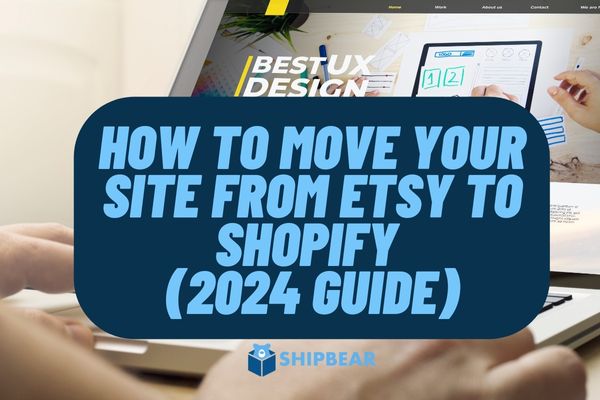Thinking about making the leap from Etsy to Shopify? You’re not alone. Moving from a marketplace like Etsy to your own independent store on Shopify can provide greater control, customization, and growth potential.
This guide will walk you through the entire process, ensuring a smooth transition so you can keep focusing on what you do best—creating amazing products.
Pre-Migration Checklist
Before you make the move, it’s essential to prepare adequately. Here are key points to consider:
- Backup Your Etsy Store: Download all your product data, customer information, and sales history.
- Inventory Assessment: Review your current inventory and decide what items will be listed on Shopify.
- Financial Planning: Understand the costs involved in running a Shopify store, including subscription fees and payment processing charges.
Setting Up Your Shopify Store
Setting up your Shopify store properly is essential for a smooth transition from Etsy and for long-term success. A well-structured setup ensures your store operates efficiently, providing a seamless experience for your customers.
According to Shopify’s data, 60% of merchants who migrate from other platforms, like Etsy, see a significant increase in sales within the first six months.
Moreover, Shopify’s robust infrastructure is particularly effective for dropshipping businesses, with 87% of dropshippers reporting a positive impact on their business operations.
From choosing the right plan to customizing your store’s design, proper setup is crucial to leverage Shopify’s full potential and achieve sustainable growth.
Here are the key steps to follow when setting up your Shopify store:
- Create a Shopify Account:
- Go to Shopify and sign up for an account.
- Choose a plan that suits your needs. (You can start with a 14-day free trial.)
- Choose a Theme:
- Browse through the Shopify Theme Store.
- Select a theme that matches your brand’s aesthetics.
- Customize the theme using the Shopify editor to fit your branding. Adjust colors, fonts, and layout as required.
- Customize Your Store:
- Add your logo and create a favicon.
- Set up your navigation menus, including main menu and footer links.
- Add essential pages like About Us, Contact, and Shipping Policy.
Importing Products

Properly importing your products from Etsy to Shopify is a critical step in the migration process. Accurate, comprehensive product data ensures that your store is well-organized and that your listings are optimized for search engines.
This includes importing product descriptions, images, pricing, and SKUs. Failing to do so can result in lost data, misrepresented products, and decreased customer satisfaction.
Maintaining a consistent look and feel for returning customers is equally important, especially if your previous design on Etsy was successful.
This familiarity can help in easing the transition for your customers, keeping them loyal and reducing the dropout rate.
By replicating the successful elements of your Etsy store—such as color schemes, logo placement, and overall layout—you can provide a sense of continuity and comfort.
Customers appreciate the seamless experience, which can translate into higher retention rates and more repeat purchases.
Here are the key steps to follow when importing your products:
- Export Your Etsy Products:
- Use the Etsy data export tool to download your product listings.
- Format the CSV file to match Shopify’s import requirements.
- Import to Shopify:
- Navigate to Products > Import in your Shopify dashboard.
- Upload your CSV file and review the imported products.
- Optimize Product Descriptions and Images:
- Ensure your descriptions are detailed and SEO-friendly.
- Use high-quality images that showcase your products effectively.
Managing Inventory
Effective inventory management is essential for ensuring customer satisfaction and smooth business operations. Poor inventory management can lead to issues like stockouts and overstocking, which can negatively impact customer satisfaction.
According to a study by IHL Group, retailers worldwide lose a staggering $1.75 trillion annually due to out-of-stock items, which not only affects sales but also diminishes customer trust and loyalty.
Moreover, 34% of customers who experience stockouts will switch to a competitor, as highlighted in research from the Harvard Business Review.
In contrast, well-managed inventory contributes to a positive shopping experience. Efficient inventory practices ensure that popular products are readily available, reducing the likelihood of stockouts that disappoint customers.
Furthermore, businesses that maintain an optimized inventory level often enjoy higher customer satisfaction rates; in fact, a survey by Wiser found that 75% of shoppers are more likely to return to a store that consistently has the products they need in stock.
By optimizing your inventory management, you can keep your customers happy, encourage repeat business, and enhance overall operational efficiency.
Here is how to manage your inventory effectively on Shopify:
- Update Stock Levels:
- Regularly update your inventory to reflect accurate stock levels.
- Use Shopify’s inventory management tools to track product quantities and set up automatic stock updates.
2. Set Up Inventory Alerts:
- Enable low stock alerts to keep track of inventory levels.
- Use Shopify’s inventory management tools to monitor stock and avoid overselling.
3. Organize Products by Collection:
- Create collections and categorize your products for easy navigation and inventory management.
- Grouping products by type, season, or promotion can streamline inventory tracking and reordering processes.
- Use tags and filters to help customers find what they’re looking for.
How Shipbear Can Help Streamline Your Inventory

Shipbear is an all-in-one dropshipping agent that takes care of everything, from sourcing and warehousing to branding, customizations, logistics, and fulfillment.
By partnering with Shipbear, you can significantly streamline your inventory management processes.
Our comprehensive services ensure that your inventory is always up-to-date and accurately reflects stock levels, helping you avoid the common pitfalls of poor inventory management such as stockouts and overstocking.
Marketing Your New Store
The ecommerce landscape is highly competitive, and effective marketing strategies can significantly impact your store’s visibility and success. According to HubSpot, businesses that prioritize marketing efforts are 13 times more likely to see a positive return on investment.
Furthermore, email marketing has been shown to have a median ROI of 122%, as reported by DMA, making it a potent tool for nurturing customer relationships and encouraging repeat purchases.
Social media marketing is equally crucial, with Hootsuite data indicating that 73% of marketers believe their efforts through social media have been “very effective” or “somewhat effective” for their business.
Additionally, a survey by Retail Dive found that 87% of consumers begin their shopping journey online, emphasizing the importance of a robust online presence. Investing in SEO, content marketing, and pay-per-click advertising can help draw organic traffic to your Shopify store, increasing the likelihood of converting visitors into customers.
Here are some key marketing strategies to consider for your Shopify store:
- Email Marketing:
- Build a subscriber list and send regular newsletters promoting products and sales.
- Utilize automated email campaigns to engage with customers based on their shopping behavior.
2. Social Media Marketing:
- Leverage platforms like Instagram, Facebook, and Pinterest to showcase your products and interact with potential customers.
- Run targeted ad campaigns to reach your desired audience.
3. Content Marketing and SEO:
- Create valuable content that resonates with your target audience, such as blog posts, videos, and tutorials.
- Optimize your website and product pages for search engines to improve your organic search rankings.
4. Pay-Per-Click (PPC) Advertising:
- Use Google Ads and social media ads to drive traffic to your store.
- Monitor and adjust your campaigns to maximize ROI.
Final Checks
Before you launch, double-check the following:
- Payment Settings – Ensure your payment gateways are correctly set up and tested.
- Shipping Settings -Configure your shipping rates and options.
- Legal Pages -Make sure all legal pages like Terms of Service and Privacy Policy are in place.
Go Live!
Launch day is here! Here’s how to manage it:
- Publish Your Store -Remove the password protection to make your store live.
- Monitor Performance – Use Shopify Analytics to track your store’s performance.
- Monitor traffic, sales, and customer behavior.
Conclusion
Congratulations! You’ve successfully moved from Etsy to Shopify. This transition can open new doors for your business, giving you more control and opportunities for growth. If you need any assistance, don’t hesitate to book a call with one of our CloMo stylists, who can help refine your style and choose staple pieces for your store.



